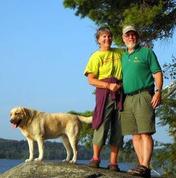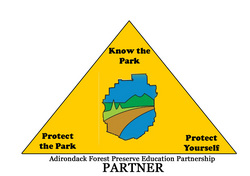Journal of the New York State Outdoor Education Association
Spring/Summer 1977
Wilderness Recreation Education By Jack Drury
What is Wilderness Recreation Education? Today’s accepted definition of wilderness comes from the 1964 Wilderness Act in which Congress used the definition, an area where the earth and its community of life are untrammeled by man, where man himself is a visitor who does not remain.”1 Recreation is often defined as the wise use of one’s leisure time. If this is the case, then Wilderness Recreation Education could be defined as instruction in the wise use of one’s leisure time in an area where the earth and its community of life are untrammeled by man. Or, in a more condensed form, it could be the instruction in leisure activities in the natural environment that has not suffered from the impact of man.
The basic objectives in offering a Wilderness Recreation Education program are: (1) to offer students an opportunity to be involved with direct learning in the outdoors; (2) to instill an understanding of ways to exist within and enjoy the wilderness environment; and (3) to develop an awareness of and appreciation for the need to conserve and maintain the wilderness environment for generations to come.
As the length of the work week decreases in our nation and the efficiency of our productivity increases, people are finding more and more leisure time in their lives. The average per capita income is rising, just as the number of working hours is decreasing. In meeting the special problems related to increasing incomes and increasing amounts of leisure time, there is a growing responsibility for our society through educational institutions to provide for the development of recreational skills in all individuals. Millions of people have turned to our wilderness environment to spend their leisure time, thus putting increased pressure on our limited wilderness resources. Since 1940, the U.S. population has increased 63 %, while trail use in many wilderness areas has increased by 1000%! 2
Recreation Equipment Inc., one of the largest outlets for wilderness recreation equipment, has pointed out that in 1971 their increase in sales over the previous year was more than its total sales in 1967. This would seen to indicate that there were more people using wilderness areas for the first time than the total number of people using such areas in 1967. 3
Future demands on our wilderness resources will increase. The Bureau of Outdoor Recreation conservatively estimates that hiking will increase 78% from 1965 to 1980. Wilderness camping has more than doubled since 1970 in our National Parks. Today, there are an estimated 10 million hikers trying to use a limited amount of wilderness.6 The result is a series of related problems, the most serious one being safety. Many individuals swept away by the popularity of wilderness recreation, have not had any formal education in the ways of the wilderness. The result has often been accidents and tragedy. In the Adirondack Mountains alone, there were over 100 search-and-rescue missions conducted during the last two years with several deaths reported. Two deaths were attributed directly to a lack of knowledge about the outdoors. The individuals were ill prepared, lacked basic knowledge, and in one ease, had poor leadership. Two individuals died of hypothermia also known as the ‘Killer of the Unprepared.”
This past winter there were a number of spectacular rescues which fortunately avoided tragedy. Senseless tragedy was avoided only because of the greater responsibility assumed by State Rangers who have increased their surveillance of individuals using wilderness areas. Tragedy was not avoided, however, when Stephen Thomas became lost in the Adirondack High Peaks last April never to be seen again. One week later, Michael Caruso drowned on the Raquette River. In both incidents basic rules of wilderness travel were broken.
Injury and loss of life are one result of lack of Wilderness Recreation Education, but nearly as important is the growing destruction of our wilderness areas, often unintentionally done, through lack of knowledge. Many wilderness users do not realize the impact they have on the environment. They often unknowingly erode trails and litter and destroy natural vegetation, especially along lakes and streams. These wilderness users consume vast quantities of firewood and pollute wilderness watersheds with detergents and human waste. These careless actions take a high toll on the environment and take away from the great values inherent in the experience.
The past winter I spent 21 days cross-country skiing and snowshoeing across a large section of our Adirondack wilderness. It was depressing to travel through beautiful woods only to come upon a lean-to in which someone had torn up a portion of the floor to start a fire or to see someone’s garbage strewn around the campsite. Other’s thoughtlessness detracted from my own wilderness experience.
There is a definite need to inform people of the proper outdoor procedures so that their negative impact on the environment will be limited. First, we must develop and promote exemplary behavior patterns for wilderness living. Second, we must develop a wilderness ethic through which individuals can appreciate and learn to care for our wilderness resources. Without the development of exemplary behavior patterns and a wilderness ethic, all of the wilderness areas that Congress has set aside for posterity seem doomed. Paul Petzoldt, founder of the National Outdoor Leadership School, has stated, “Classified wilderness regions are not being threatened by mining, timbering, or ranching interests; the destruction is coming from those very people who fought so gallantly to get the (Wilderness) act passed. All the study, thought, and effort was devoted to putting a legislative fence around primitive areas rather than developing techniques for their proper use and conservation.”8
With the increasing number of people interested in taking advantage of our wilderness areas, we have another complex problem. Not only do we have abuse of the wilderness, but we have overuse, with too many people often crowding together to create an urban setting within the wilderness. This not only increases wilderness abuse, but greatly detracts from the value of the wilderness experience. While education alone cannot remedy this problem totally, it is noteworthy to point out that studies have shown that the carrying capacity of a wilderness area (the number of people an area can hold before the wilderness becomes damaged and loses its natural character) is more than doubled if campers have experienced a program in wilderness recreation education!
These are some of the problems in wilderness recreation. A vocational, avocational Wilderness Recreation Education program could help meet these problems head-on. Through wilderness Recreation Education, individuals could acquire the skills necessary to pursue wholesome outdoor recreational activities without overtaxing our wilderness resources; individuals could acquire the leadership skills and knowledge of the dangers often involved in outdoor experiences, how to avoid or how to handle them, should they occur; individuals could learn the exemplary behavior patterns necessary to preserve wilderness areas, thus allowing large numbers of people to make use of our wild outdoors, yet still maintaining the natural wilderness experience. An important by-product will be increasing the carrying capacity of wilderness areas, thus limiting or preventing overuse.
Unfortunately, there are not enough outdoor education programs today that are helping to meet these goals. We have a critical choice - we can work, through education, to prevent the tragedy and destruction occurring within our wilderness areas or we can have government agencies regulate our wilderness resources until they resemble a large Central Park rather than a true wilderness. Restrictive regulatory measures are already being taken by the National Forest Service, National Park Service, and state wilderness management agencies. But these policies are unfortunately, though necessarily, more concerned with controlling numbers of people than with educating the public in wise use of the wilderness areas. The day has already come where we must reserve space in a wilderness camping area and we can only camp in specific locations. Unless we carefully educate, the freedom of wandering through wilderness areas and appreciating their splendid wonders will be lost. No longer will wilderness be, “an area where the earth and its community of life are untrammeled by man…”
We must not let this happen. Sound programs in Wilderness Recreation Education can no longer be seen as vague, distant options. They are basic and become more of a critical need each year. Our future and that of our children depend on it!
FOOTNOTES 1. Howard Zahniser. 1964 Wilderness Act, quoted by ed. Melville Bell Grosvenor in Wilderness U.S.A. (Washington, D.C., National Geographic Society, 1973), p. 10.
2. Harvey Manning, “Where Did All These Damn Hikers Come From?”, Backpacker, 10 (Spring, 1975), p. 39-
3. Ibid. p. 38. 4. Robert C. Lucas and Robert P. Rinehart, “The Neglected Hiker”, Backpacker, 13 (February, 1976), p. 35.
5. “In His Own Words”, People, (June 7, 1976), p. 54.
6. Maurice H. Pomeranz, “Backpacking Becomes Big Business”, Backpacker, 5 (Spring, 1974), p. 32.
7. “32 Search and Rescue Missions in High Peaks Area Conducted in 1974”, Lake Placid News, (December 5, 1974).
8. Paul Petzoldt, The Wilderness Handbook, (New York, W.W. Norton & Co., 1974).



 RSS Feed
RSS Feed
